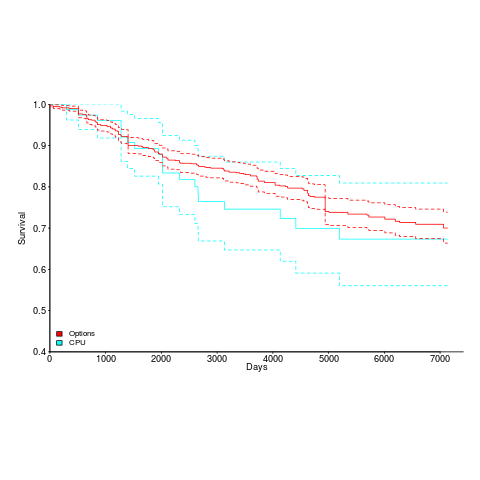Archive
Growth and survival of gcc options and processor support
Like any actively maintained software, compilers get more complicated over time. Languages are still evolving, and options are added to control the support for features. New code optimizations are added, which don’t always work perfectly, and options are added to enable/disable them. New ways of combining object code and libraries are invented, and new options are added to allow the desired combination to be selected.
The web pages summarizing the options for gcc, for the 96 versions between 2.95.2 and 9.1 have a consistent format; which means they are easily scrapped. The following plot shows the number of options relating to various components of the compiler, for these versions (code+data):

The total number of options grew from 632 to 2,477. The number of new optimizations, or at least the options supporting them, appears to be leveling off, but the number of new warnings continues to increase (ah, the good ol’ days, when -Wall covered everything).
The last phase of a compiler is code generation, and production compilers are generally structured to enable new processors to be supported by plugging in an appropriate code generator; since version 2.95.2, gcc has supported 80 code generators.
What can be added can be removed. The plot below shows the survival curve of gcc support for processors (80 supported cpus, with support for 20 removed up to release 9.1), and non-processor specific options (there have been 1,091 such options, with 214 removed up to release 9.1); the dotted lines are 95% confidence internals.

Using Black-Scholes in software engineering gives a rough lower bound
In the financial world, a call option is a contract that gives the buyer the option (but not the obligation) to purchase an asset, at an agreed price, on an agreed date (from the other party to the contract).
If I think that the price of jelly beans is going to increase, and you disagree, then I might pay you a small amount of money for the right to buy a jar of jelly beans from you, in a month’s time, at today’s price. A month from now, if the price of Jelly beans has gone down, I buy a jar from whoever at the lower price, but if the price has gone up, you have to sell me a jar at the previously agreed price.
I’m in the money if the price of Jelly beans goes up, you are in the money if the price goes down (I paid you a premium for the right to purchase at what is known as the strike price).
Do you see any parallels with software development here?
Let’s say I have to rush to complete implementation some functionality by the end of the week. I might decide to forego complete testing, or following company coding practices, just to get the code out. At a later date I can decide to pay the time needed to correct my short-cuts; it is possible that the functionality is not used, so the rework is not needed.
This sounds like a call option (you might have thought of technical debt, which is, technically, the incorrect common usage term). I am both the buyer and seller of the contract. As the seller of the call option I received the premium of saved time, and the buyer pays a premium via the potential for things going wrong. Sometime later the seller might pay the price of sorting out the code.
A put option involves the right to sell (rather than buy).
In the financial world, speculators are interested in the optimal pricing of options, i.e., what should the premium, strike price and expiry date be for an asset having a given price volatility?
The Black-Scholes equation answers this question (and won its creators a Nobel prize).
Over the years, various people have noticed similarities between financial options thinking, and various software development activities. In fact people have noticed these similarities in a wide range of engineering activities, not just computing.
The term real options is used for options thinking outside of the financial world. The difference in terminology is important, because financial and engineering assets can have very different characteristics, e.g., financial assets are traded, while many engineering assets are sunk costs (such as drilling a hole in the ground).
I have been regularly encountering uses of the Black-Scholes equation, in my trawl through papers on the economics of software engineering (in some cases a whole PhD thesis). In most cases, the authors have clearly failed to appreciate that certain preconditions need to be met, before the Black-Scholes equation can be applied.
I now treat use of the Black-Scholes equation, in a software engineering paper, as reasonable cause for instant deletion of the pdf.
If you meet somebody talking about the use of Black-Scholes in software engineering, what questions should you ask them to find out whether they are just sprouting techno-babble?
- American options are a better fit for software engineering problems; why are you using Black-Scholes? An American option allows the option to be exercised at any time up to the expiry date, while a European option can only be exercised on the expiry date. The Black-Scholes equation is a solution for European options (no optimal solution for American options is known). A sensible answer is that use of Black-Scholes provides a rough estimate of the lower bound of the asset value. If they don’t know the difference between American/European options, well…
- Partially written source code is not a tradable asset; why are you using Black-Scholes? An assumption made in the derivation of the Black-Scholes equation is that the underlying assets are freely tradable, i.e., people can buy/sell them at will. Creating source code is a sunk cost, who would want to buy code that is not working? A sensible answer may be that use of Black-Scholes provides a rough estimate of the lower bound of the asset value (you can debate this point). If they don’t know about the tradable asset requirement, well…
- How did you estimate the risk adjusted discount rate? Options involve balancing risks and getting values out of the Black-Scholes equation requires plugging in values for risk. Possible answers might include the terms replicating portfolio and marketed asset disclaimer (MAD). If they don’t know about risk adjusted discount rates, well…
If you want to learn more about real options: “Investment under uncertainty” by Dixit and Pindyck, is a great read if you understand differential equations, while “Real options” by Copeland and Antikarov contains plenty of hand holding (and you don’t need to know about differential equations).
Recent Posts
Tags
Archives
- May 2025
- April 2025
- March 2025
- February 2025
- January 2025
- December 2024
- November 2024
- October 2024
- September 2024
- August 2024
- July 2024
- June 2024
- May 2024
- April 2024
- March 2024
- February 2024
- January 2024
- December 2023
- November 2023
- October 2023
- September 2023
- August 2023
- July 2023
- June 2023
- May 2023
- April 2023
- March 2023
- February 2023
- January 2023
- December 2022
- November 2022
- October 2022
- September 2022
- August 2022
- July 2022
- June 2022
- May 2022
- April 2022
- March 2022
- February 2022
- January 2022
- December 2021
- November 2021
- October 2021
- September 2021
- August 2021
- July 2021
- June 2021
- May 2021
- April 2021
- March 2021
- February 2021
- January 2021
- December 2020
- November 2020
- October 2020
- September 2020
- August 2020
- July 2020
- June 2020
- May 2020
- April 2020
- March 2020
- February 2020
- January 2020
- December 2019
- November 2019
- October 2019
- September 2019
- August 2019
- July 2019
- June 2019
- May 2019
- April 2019
- March 2019
- February 2019
- January 2019
- December 2018
- November 2018
- October 2018
- September 2018
- August 2018
- July 2018
- June 2018
- May 2018
- April 2018
- March 2018
- February 2018
- January 2018
- December 2017
- November 2017
- October 2017
- September 2017
- August 2017
- July 2017
- June 2017
- May 2017
- April 2017
- March 2017
- February 2017
- January 2017
- December 2016
- November 2016
- October 2016
- September 2016
- August 2016
- July 2016
- June 2016
- May 2016
- April 2016
- March 2016
- February 2016
- January 2016
- December 2015
- November 2015
- October 2015
- September 2015
- August 2015
- July 2015
- June 2015
- May 2015
- April 2015
- March 2015
- February 2015
- January 2015
- December 2014
- November 2014
- October 2014
- September 2014
- August 2014
- July 2014
- June 2014
- May 2014
- April 2014
- March 2014
- February 2014
- January 2014
- December 2013
- November 2013
- October 2013
- September 2013
- August 2013
- July 2013
- June 2013
- May 2013
- April 2013
- March 2013
- February 2013
- January 2013
- December 2012
- November 2012
- October 2012
- September 2012
- August 2012
- July 2012
- June 2012
- May 2012
- April 2012
- March 2012
- February 2012
- January 2012
- December 2011
- November 2011
- October 2011
- September 2011
- August 2011
- July 2011
- June 2011
- May 2011
- April 2011
- March 2011
- February 2011
- January 2011
- December 2010
- November 2010
- October 2010
- September 2010
- August 2010
- July 2010
- June 2010
- May 2010
- April 2010
- March 2010
- February 2010
- January 2010
- December 2009
- November 2009
- October 2009
- September 2009
- August 2009
- July 2009
- June 2009
- May 2009
- April 2009
- March 2009
- February 2009
- January 2009
- December 2008
Recent Comments